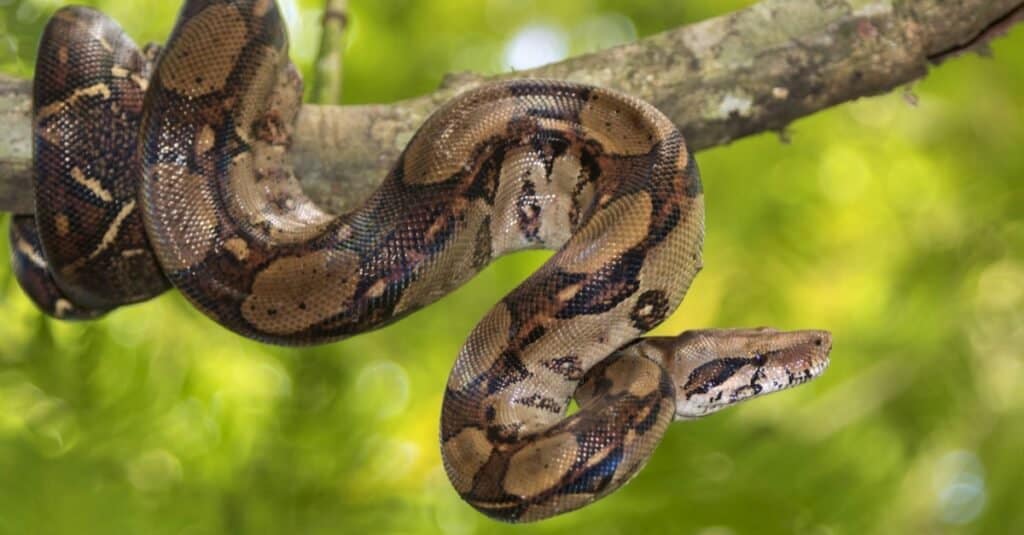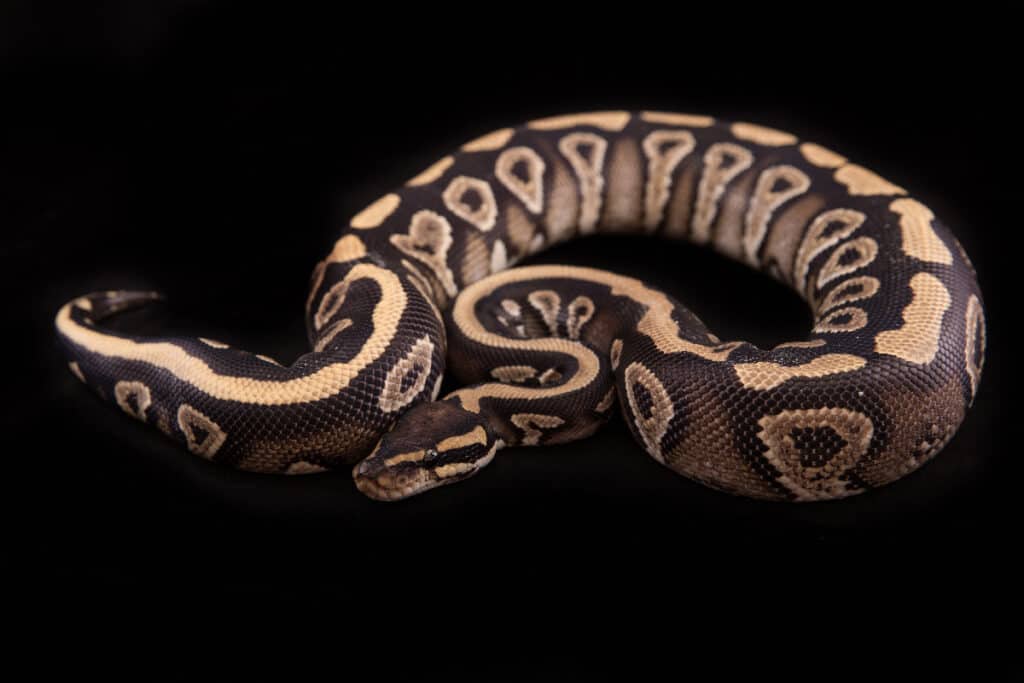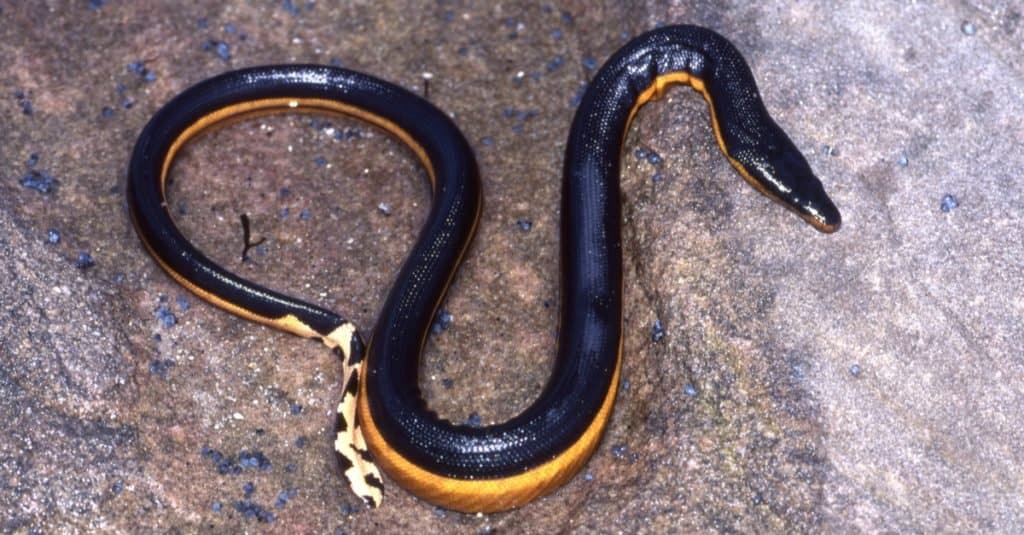Believe it or not, Hawaii does not have any native snake species that are indigenous to the area! While the islands boast a wide variety of native animals and plants, any snake in Hawaii is considered invasive. Not only are snakes not common in Hawaii, but they are also not welcome at all. However, there are seven invasive species of snakes that are sometimes found in Hawaii, and four are dangerous. The top four largest (and most dangerous) snakes in Hawaii are boa constrictors, ball pythons, brown tree snakes, and yellow-bellied sea snakes. But wait, aren’t two of those pets? They are, and in Hawaii, which is a real problem!
Hawaii Has No Native Snake Species

Hawaii is undeniably beautiful and has many indigenous species that populate the gorgeous landscape. However, there are no native snakes that are found in Hawaii!
©iStock.com/paulacobleigh
There are seven snakes that can be found in Hawaii, but none of them are native to the islands. Of those, only four can be considered large enough or dangerous enough to harm a person. However, any non-native species can cause devastation. When it comes to locations that do not have indigenous snake species, the threat to other animals is severe. In some locations, the introduction of a non-native snake has even caused other species to go extinct. While exotic pets like snakes are beautiful and unique companions, they can be deadly to other species if left unchecked!
Are There Penalties For Having A Snake In Hawaii?
Snakes of any species are illegal in Hawaii and any invasive species found are removed or eliminated. This includes both dangerous or venomous snakes as well as common exotic pets like pythons or boas. Hawaii imposes strict and extremely high fines or even prison terms for bringing a snake into the state. The Department of Agriculture goes to great lengths to protect the Hawaiian ecosystem, so if you see a snake in Hawaii, make sure to let them know!
The Top Four Largest (And Most Dangerous) Snakes In Hawaii
Of the four species considered the biggest and the most dangerous, two are venomous and two are constrictors. We started with the largest snakes that end up in the state of Hawaii, but the biggest does not always mean the most dangerous.
As a bonus, we also included the smallest and least dangerous snake found in Hawaii. This highly invasive little species is the only snake that Hawaii does not really mind at all!
Boa Constrictors

Boa constrictors are non-venomous snakes and species found in Hawaii are often lost or abandoned pets, or brought into the state by the illegal exotic pet trade.
©Natalia Kuzmina/Shutterstock.com
| Size | Up to 9 feet long |
| Location | Trees, dense plant growth, and specific locations are species-dependent |
| Danger to humans | Mild danger to humans, but a huge threat to Hawaii’s ecosystem |
| Behavior | Solitary hunters that constrict their prey, non-venomous |
Boa constrictors can be identified by their heavy and muscular bodies, multiple colors that range from browns to greens, and their distinctive patterns. As most species of invasive boas are lost or illegal exotic pets, coloring and markings may vary widely. Boa constrictors have triangular heads and are non-venomous.
In Hawaii, there have been nine reports of boa constrictors since 2011.
Ball Pythons

Like the boa constrictor, ball pythons are also exotic pets brought to Hawaii illegally. While not overly dangerous to humans, they are a real danger to the ecosystem.
©Sanne Romijn Fotografie/Shutterstock.com
| Size | Up to 6 feet long |
| Location | Forests, dense tree canopies, or ground cover, usually brought to Hawaii illegally as pets |
| Danger to humans | Minimal danger to humans, but a large threat to the Ecosystem in Hawaii |
| Behavior | Non-confrontational and non-aggressive, as most found in Hawaii are lost or abandoned pets. |
Ball pythons come in many color variations and patterns but are easily identified by their lean bodies and large heads. All ball python’s markings are unique, like human fingerprints. Like the boa constrictor, most pythons found in Hawaii are mildly dangerous. As a constrictor, they lack venom and are often little danger to humans.
However, they are dangerous to Hawaii’s ecosystem and are often abandoned or lost pets. There have only been three reported ball pythons in Hawaii in the last 7 years.
Brown Tree Snakes

Brown tree snakes are a threat to both humans and the ecosystem in Hawaii. They are venomous and capable of wiping out entire species, which is why Hawaii has trained dogs skilled in eradicating them!
©Janelle Lugge/Shutterstock.com
| Size | Up to 6 feet long |
| Location | Wooded areas and trees |
| Danger to humans | Venom can be deadly without medical treatment |
| Behavior | Aggressive and known to bite without warning, devastating to the wildlife in Hawaii |
Brown tree snakes can be identified by their thin and agile bodies, narrow heads, and catlike eyes. They are light amber colored on the back, with tan or light brown bellies and muted brown spots.
This species is a danger to both humans and the ecosystem in Hawaii. They are highly invasive and have wiped-out 70 percent of competitive predators in Guam. Currently, there are only four brown tree snakes in Hawaii, used to train dogs to track and eliminate the species.
Yellow-Bellied Sea Snakes

Yellow-bellied sea snakes are one of the most deadly venomous snakes in the world, but they are rarely spotted outside of the ocean. Though found in the waters surrounding Hawaii, they are rarely encountered and spend 90 percent of their time underwater.
©Ken Griffiths/Shutterstock.com
| Size | Up to 4.4 feet long |
| Location | On the ocean floor beneath rocks, spends 90 percent of life underwater |
| Danger to humans | Venom is highly toxic and deadly, but no attacks have been reported |
| Behavior | This species is rarely spotted and is highly evasive. |
The yellow-bellied sea snake can be identified by its signature yellow underbelly and the black stripe down the back. The species also has a distinctive paddle-shaped tail covered in yellow and black spotting. It has a thin and narrow body with a small head.
While listed as a non-native Hawaiian species, this is due to its underwater habitat. While the yellow-bellied sea snake is one of the most venomous snakes in the world, it is elusive and rarely spotted. Therefore, while it is the deadliest snake found in the area, it is not considered a threat!
How Do Invasive Snake Species Get To Hawaii?
Hawaii works tirelessly to limit or eliminate invasive snakes, but human travel or illegal activities can pose real risks. The fines and penalties for having a snake in Hawaii are strictly enforced, and even pet snakes are illegal. However, international travel, shipping, and illegal trade are all ways invasive species can wreak havoc on the island ecosystem.
International Shipping: Snakes On Planes
Believe it or not, some species of snakes really do end up on planes. In Hawaii, this is a known threat in the case of the brown tree snake. The species has an uncanny ability to find its way onto cargo ships and airplanes that transport goods. The species is highly invasive and wreaks havoc on local wildlife, which is why Hawaii is always on guard with dogs trained specifically to eliminate them.
Exotic Pets: Illegal In Hawaii
Pet snakes of any species are illegal in Hawaii, primarily due to the threat to the ecosystem of the islands. Locations like Hawaii that have no native snakes must be vigilant to protect the local wildlife. Invasive, non-native species of any kind have the potential to wipe out entire populations.
Unfortunately, due to the highly lucrative illegal market exotic animal trade, species like pythons or boas get past customs. Therefore, Hawaii’s Department Of Agriculture imposes strict penalties for having a snake in the state. These penalties include a fine of up to $200,000.00 and up to 3 years in prison.
The Brahminy Blindsnake: An Invasive Species That Is Allowed To Stay

Brahminy Blindsnakes are silver gray, charcoal gray, or purple. Though they are an invasive species in Hawaii, they are such a low threat they are allowed to stay!
©Radiant Reptilia/Shutterstock.com
There is a highly invasive species of snake that Hawaii turns an indulgent blind eye to! The Brahminy blindsnake is between 4.4 and 6.5 inches long and looks like a colorful earthworm. The species has a slim body that is light grey, charcoal, or purple with a grey or brown underbelly.
The species originates in southeast Asia, but due to the international plant trade, they are now found worldwide. The Brahminy is also parthenogenic, meaning they are all female and can reproduce quickly without mating. They like human gardens and backyards and live in soil, leaves, or rotten logs in high-humidity areas. They pose no danger to humans or pets, and hunt termites and ants!
Summary Of The Top Four Largest (And Most Dangerous) Snakes In Hawaii
| Rank | Snake |
|---|---|
| 1 | Boa Constrictor |
| 2 | Ball Python |
| 3 | Brown Tree Snake |
| 4 | Yellow-Bellied Sea Snakes |
The photo featured at the top of this post is © Jan Hejda/Shutterstock.com
Discover the "Monster" Snake 5X Bigger than an Anaconda
Every day A-Z Animals sends out some of the most incredible facts in the world from our free newsletter. Want to discover the 10 most beautiful snakes in the world, a "snake island" where you're never more than 3 feet from danger, or a "monster" snake 5X larger than an anaconda? Then sign up right now and you'll start receiving our daily newsletter absolutely free.
Thank you for reading! Have some feedback for us? Contact the AZ Animals editorial team.






